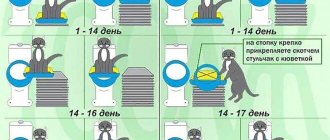Why toilet train a cat?
When you get a cat, you get a lot of trouble. One of the regular concerns of every owner of a furry pet is the constant removal of the tray and the purchase of litter. If everyone in the household works and spends little time at home, this causes the animal some discomfort. Everyone benefits from training a cat to go to the toilet on the toilet:
- you don’t need to keep track of the remaining filler at home;
- you no longer spend money on filler, on a new tray to replace the old one;
- a tray is not needed, which means it frees up space and is not visible to guests;
- You will no longer need to clean up after the cat;
- the characteristic odor disappears.
Once you have trained your cat to use the toilet, all you need to do is press the flush button.
Let's start with the tray
It is necessary to accustom your baby to the tray from the first days after birth. Kittens have a peculiarity - they defecate immediately after eating. If you are patient and make sure that your baby goes to the toilet immediately after eating for several days in a row, then your pet will not have problems with the toilet in the future.
The cat must be handled carefully, without causing pain. When the kitten has eaten, carefully pick it up under the tummy and take it to the tray. If the kitten crawls out of the toilet without emptying itself, it is returned back. After completing toilet chores, the kitten is praised.
The toilet container is placed in a convenient place; sometimes the kitten itself will determine such a place, trying to empty itself there. Then the tray is gradually moved closer to the toilet room.
First, the cat is accustomed to the sound of water pouring out of the cistern. They do this gradually, drain the water with the door open so that the cat hears the noise from afar, then press the drain in front of the animal. While the water is roaring, they hold the cat in their arms, stroke it, say kind words, and show how the water flows.
Tray training a kitten
How to accustom a kitten to dry food
How to stop a cat from shitting in the wrong place
Who can be trained and who shouldn't
Almost any cat can be trained to use the toilet. However, there are certain restrictions. Who should not be toilet trained:
- cats leading a sedentary lifestyle and pregnant cats - because of their awkwardness;
- It is also better to leave nursing cats alone;
- older, sick or weakened cats should not be tormented by attempts to give up the tray;
- Kittens that are too small are not yet ready to go to the toilet; they are at risk of falling.
The optimal age for training a cat is 5-6 months. At this age, their psyche is still flexible enough to learn a new skill, and they are not too young to fall awkwardly.
How to train a cat to use the toilet after using the litter box?
If the owner wants his cat to go not to the tray, but to the toilet, this is not a whim at all. This method of providing animals with their natural needs has a number of advantages:
- There will be no cat litter box in the house. For many, placing this element of a pet dowry is difficult, especially if the home is small. Firstly, cats like to go to the toilet in a secluded place; a corner is needed for the litter box. Secondly, cats do not go to the toilet where they eat. Thirdly, sometimes a cat potty spoils the aesthetics of the room. One cannot but agree that it is much more convenient if the animal goes to the toilet.
- There will be no need to waste time and money on buying litter for the tray. Despite the fact that the filler is relatively inexpensive (depending on the type, of course), you usually need a lot of it, and a lot of money goes out of the family budget. Cat on the toilet - savings for the family.
- If a cat relieves itself on the toilet, the house will not smell of its discharge, and there will be no traces of wet paws on the floor. Of course, provided that they immediately clean up after the fluffy one. But even if the cat’s “business” goes unnoticed for some time, the toilet is an isolated room with good ventilation.
If a cat goes to the toilet, it is convenient, economical and hygienic.
IMPORTANT: Only an adult healthy cat who uses a litter tray can be toilet trained. A small kitten may fall into the bowl of a plumbing fixture, choke or get injured. You need to wait until he grows up. An old cat with sore joints or an overweight animal is unlikely to jump on the toilet and, most likely, will make puddles and piles on the rug next to it. These nuances must be taken into account.
How to train a cat to use the litter box so that later it can go to the toilet is written in this article: link
They say that animals, like people, develop a habit within three weeks. Of course, all cats are individual, and some especially lazy ones need much more time to toilet train, up to 2 months. But experienced cat owners say that absolutely everyone can be taught to go to the toilet.
Preparing to teach an animal to relieve itself in the toilet consists of three stages and requires certain preparation from the owners:
- It is necessary to prepare the bathroom, remove everything unnecessary from there, and free up space near the toilet where the cat's potty will be temporarily located. If we are talking about a private house or a large apartment with several bathrooms, choose the one that is more accessible for the cat, for example, on the ground floor.
- You will also need some equipment: a potty that the cat usually goes into, a training tray (discussed below), litter that can be flushed down the drain, cardboard boxes or old newspapers that will lift the tray.
- Learn to keep the bathroom door open so that the cat can come in at any time.
- Learn to keep the toilet lid open. Guests at home will always have to be warned about this. If the owners have the habit of lowering the lid, they themselves will have to relearn. You need to remember: if the cat is accustomed to the toilet, its closed lid equals a puddle or pile in the corner.
- Stock up on detergents, because now you will have to wash and clean the toilet more often.
IMPORTANT: If you can’t buy a convenient training kit for training your pet to go on the toilet, you can make it yourself, or even do without it.
Only adult healthy cats who regularly use the litter box are trained to use the toilet.
When the bathroom is ready, the cat's litter box is moved into it. It is better to do this gradually, moving the tray closer and closer to the toilet so that the cat does not get confused and start “walking” anywhere. Afterwards the actual training begins:
- The first stage takes approximately two weeks. The tray is placed near the toilet. Cardboard or newspapers are placed under it. Every day they raise the tray higher and higher, so that eventually it is level with the toilet. The cat will get used to the fact that he will need to jump onto the tray, and then he will easily climb onto the toilet.
- If there is no special tray, a regular one with low sides is placed on the toilet lid. Leave it in this position for two days so that the cat gets used to jumping on the toilet every time he wants to go to the toilet.
- Remove the potty from the toilet. They monitor the animal’s behavior for several days, identifying whether it has developed the habit the owners need.
Stages of toilet training a cat.
IMPORTANT: If, when training a cat to go to the toilet on the toilet, he commits sins a couple of times, under no circumstances should you scold him for this. Such a way of relieving himself is unnatural for him, contrary to his instincts. The animal is under stress, you need to be patient and consistent.
Toilet training a cat: stage 1.
Toilet training a cat: stage 2.
If toilet training ends in failure, do not despair. Each cat has its own individual characteristics. They don't like confined spaces.
Others are shy, they instinctively bury their feces, and the option without litter is not for them. Still others find it uncomfortable to sit on the toilet lid because of their size, etc. When you get a pet, you need to think not only about your desires, but also about its comfort.
Moreover, now you can choose the trays for cats that you want, this article will help you choose the most convenient one: link
Preliminary preparation
Preliminary preparation is needed in two cases:
- the cat is afraid to go to the toilet;
- the cat does not know how to use the litter box;
In the first case, accustom the animal to the toilet gradually. Pick him up and carry him inside, let him get comfortable. If you keep the door slightly open, the cat will gradually show interest in the room. When your pet can fearlessly go inside, accustom him to the sound of water flushing. To prevent the cat from being afraid, hold it in your arms. Toilet training begins only after the anxiety disappears.
In the second case, use the litter box training method. When this skill is mastered perfectly, move on to the next stage.
Training technique
When teaching your cat new things, be persistent and consistent. A special technique tested by many cat owners will help you achieve the desired result.
The technique does not require special devices. You can make do with improvised means - take a cat litter box and prepare old newspapers.
- The first step is to start moving the cat's litter box toward the toilet. Move slowly, a maximum of 3 centimeters per day, so that your pet does not become stressed by sudden changes.
- The second step is to start raising the tray higher when it is near the toilet and the animal does not express dissatisfaction. Every day, add several newspapers under the tray, up to a maximum of two centimeters. Be sure to pay attention to the stability of the tray, otherwise the process will take a lot of time if the pet falls and gets scared. A wobbly stack will cause discomfort in the cat, and he will ignore the new litter box. As a result, the animal should get used to the fact that the tray is now at the top.
- The third step is to place the tray on the toilet and the pet can jump on it. Now you remove the plastic parts and lid from the tray. The cat must understand that he needs to do his business in such a toilet. Make sure the structure is stable.
The third stage of habituation lasts the longest. You observe how the animal behaves and how it adapts to new conditions. It is very important not to rush here so as not to provoke stress. The cat will gradually get used to the new place. When he starts going to the toilet on the toilet, the tray is removed. It is advisable to get rid of it so that the cat does not find its old litter box by the smell.
Next, there are two rules to follow:
- provide constant access to the toilet - open the door slightly or provide a “cat window” at the bottom;
- keep the toilet lid up.
Teaching Techniques
The learning process depends on the intelligence of the pet. If something doesn’t work out, they start over from any stage. The speed of learning depends on the age of the cat, its temperament, and character. As soon as the animal has good coordination and stability, training begins.
Reception No. 1
The cat owner should not push the cat out of the toilet room when he himself is there. Some animals are so inquisitive and intelligent that when they watch their owner, they can repeat his actions.
Reception No. 2
Spread the filler along the bottom of the toilet and keep the toilet door open. The cat may become interested in the smell of the litter, jump onto the toilet seat and defecate. However, this method can lead to clogging of sewer pipes, so filler should be poured rarely and in small portions.
Technique No. 3:
- When the kitten is already accustomed to the litter box, move it 5-7 cm closer to the toilet every day. There is no need to rush things; if the animal is nervous, temporarily stop the rearrangement.
- When the tray is in the toilet room, you don’t need to lift it right away - the kitten should get used to the new place.
- As soon as the pet gets used to it and gets comfortable, lift the toilet container up a little every day. For this, old magazines, cardboards, and planks are used. The stands are wider than the container; it must stand firmly, not wobble, or slide.
- During the period of time that the tray is raised, the amount of filler poured is gradually reduced.
- Raise the toilet container to the height of the seat, and slide it onto the toilet seat with one edge.
Gradually move the tray to the edge of the toilet seat more and more so that the cat gets used to it, secure the edges with adhesive tape. Do not put filler on the container's grid; the animal must get used to the fact that there is a smooth base under its paws. As soon as the pet gets used to defecating at the level of the toilet, remove the tray and watch the cat. If he does not settle on the toilet seat, return the tray to its place. Repeat actions until the bitter end.
To make it easier for the cat to jump onto the seat, place a step nearby.
Reception No. 4
They buy a deep container, cut a small hole, and lower it down the toilet. A little filler is poured around the hole, and the hole is gradually cut wider so that the cat learns to stand with its paws along the edges of the side. When he gets used to it, the container is removed.
Reception No. 5
Specialized pet stores sell pads with holes that are securely attached to the seat of the toilet seat. You can make such an overlay yourself from thick cardboard, cover it with soft material and secure it.
The overlay consists of a rim and a central round part, which is fixed to the rim. When the cat learns to defecate with the pad, the central circle is removed. A cat accustomed to the place will already stay well on the headband. After a few days, the rim is also removed.
To attract a cat to the toilet, place a little litter with the smell of cat urine under the rim of the seat. Later it is removed.
Reception No. 6
A hole is cut in the seat cover and a basket with filling poured into it is hung. To prevent the pet's paws from slipping, they are covered with cloth. You can make such a toilet yourself and quickly.
If a toilet-trained pet “puts a pile” in the wrong place, they collect what they’ve done and throw it in the toilet. They lock the animal in the same place for 10-15 minutes - he will soon understand what he did wrong.
After the cat has made its first successful attempts at hiking, immediately hide the toilet container so that it does not smell it. If the pet senses where the smell of its urine is coming from, it will gravitate there, so it is best to take the tray out of the apartment altogether.
Training using a special pad
The task of toilet training is made easier by special pads. You can make such a device yourself by cutting out a mesh liner from the tray and adjusting it to the size of the toilet. By attaching the pad to the toilet, you gradually teach the cat to go to the toilet in a new place. It’s even easier to buy a ready-made toilet tray cover at a pet store. The models have different designs, but perform the same function.
The first stage of training is similar to that described above. The owner installs a tray on top of the toilet. The difference is that you don’t need to remove it suddenly afterwards.
It is convenient to use a special device with a hole cut inside. Every five days you trim the hole, making it larger. The cat will understand that it is forbidden to step into the center of the tray. When the hole accurately follows the contours of the circumference of the toilet, there will be no need for a cover. You take it off, and your pet goes to the toilet out of habit. This training method is suitable for small and young animals.
You can buy a whole set of pads of different sizes, then you won't have to trim the hole to make it bigger. Simply replacing them every five days is enough. Don't forget to pay attention to your pet's weight so that the pad can support it.
Features of different types of toilets for cats and cats
Cat litter boxes come in different types with their own characteristics. When choosing a toilet, you need to focus on the character of your pet. Some animals refuse to relieve themselves in the device offered to them, without filler, while others are happy to use the human toilet.
Toilet tray
The tray is attached to the top bowl of the toilet, completely covering it. There is a small hole inside that helps the animal more easily adapt to new conditions. Instead of a tray, you can use any reliable container with filler.
Toilet covers for cats
Collapsible models of trays made of plastic are available for sale. The design consists of separate sections of different diameters, allowing you to adjust the size of the hole. The most popular training pad is called “Anti-scratch”.
Mode of application:
- The device is fixed on top of the plumbing bowl and filler is poured.
- Sections of the pad are removed gradually, as the animal gets used to it, starting with a smaller diameter. The volume of filler is reduced each time.
- The plastic bottom usually bends under the weight of the animal. To avoid falling, the cat will instinctively place its paws on the side of the bowl. This way she will gradually learn to go to the toilet from the edge of the plumbing fixture.
- The nozzle is removed when the animal has fully adapted to the new toilet.
Be sure to read:
How to remove the smell of cat urine: products for removing pungent odors from pets
There are models of plastic linings, divided into rings, which are not removed, but cut out. All simulators for toilet training cats are universal and suitable for animals of all ages. Their cost is low, and the kit includes instructions for use.
Separate plumbing fixture for the cat
Plumbing fixtures for animals are divided into 2 types:
- Analogue of a human toilet. It differs from a regular toilet in its smaller size and is connected to the sewer system like a human toilet. The bowl is filled with washing granules. The device has an automatic flushing system. The cat's position is recorded by infrared sensors. When she leaves the place, the sensor is triggered and the drain turns on.
- Simple tray with automatic cleaning. After the pet leaves, the dirty litter is removed by a special device into a separate container, and the toilet always remains clean.
Simple tray with automatic cleaning











